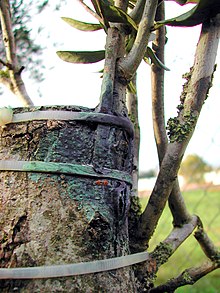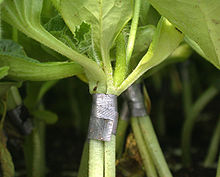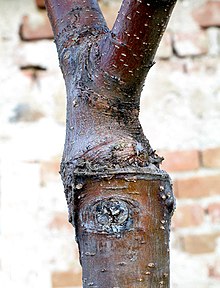Plant grafting
Under finishing or finishing refers to a traditional form of artificial vegetative propagation ( xenovegetative multiplication ) of mostly woody plants , typically roses - and fruit and walnut trees, since 1920 also of fruit vegetables (tomatoes, cucumbers and eggplant ) and melon plants.
In principle, it is a matter of transplanting a part of a plant onto another plant. Only dicotyledonous plants and naked seeds can be grafted; Monocot plants do not have the vascular cambium required for the fusing process . Since a genetic individual is reproduced in the process of grafting, it is a traditional form of cloning . A so-called base is connected to a noble rice or noble eye .
purpose
Raising plants from seeds that have arisen by means of generative propagation through pollination only extremely rarely produces offspring with exactly the same characteristics as the parent species. In the case of the species mentioned here in particular, it is not possible to maintain the properties through generative propagation, and the technique of refinement thus allows the original variety to be preserved as a clone . With these methods, individual individuals can be multiplied (all trees of a variety are genetically identical) or preserved over a very long period of time (variety purity). An example of this is the approximately 900-year-old Edelborsdorfer apple variety , which has been continuously refined on new bases.
But there are also other reasons for refinement, e.g. B. the root system of noble rice does not match the soil (lime incompatible, preferably acidic soils, but location is basic etc.), the root system of noble rice is prone to disease (e.g. lack of resistance to soil-borne fungi), too weak root system of noble rice ( e.g .: better supply of the above-ground parts of the plant), influencing the vigor (aim: weak-growing or strong-growing forms), formation of ornamental forms (e.g .: mourning, hanging, spherical forms, high trunks etc.).
The rootstocks used are mostly varieties that form strong, powerful roots and provide the plants with more nutrients and water ( e.g. pumpkin as a base for cucumbers). This makes the plants stronger and can continue to grow even in bad weather or in hot spells. Melons can therefore have up to 75% more yield and store more sugar than unprocessed ones (which means they taste sweeter, which increases sales). In Japan 92% and in Korea 95% of all melon plants are grafted. The better supply means that more and larger fruits are formed, which can increase the yield of tomatoes by around 25 to 50%, and of cucumbers by 100%. By using mycorrhiza or hydroponics , the nutrient supply and thus the yield can be increased even further.
The closer the relationship between rootstock and noble rice, the more likely it is that the processing partners will grow together. Example: plum-peach-almond-apricot (genus Prunus ). Usually, however, those partners are used that have proven themselves in practice.
No new species can be bred by means of plant grafting. New species can only emerge generatively from random seedlings or through breeding . When individual parts of the plant ( buds ) are mutated , properties can be reproduced and maintained independently as whole individuals through refinement. Refinement options are also used in modern green genetic engineering .
A refined plant is a chimera , i.e. an organism that is made up of genetically different tissues and yet represents a uniform individual . An exchange of genetic information between the genetically different cells of the chimera (see also horizontal gene transfer ) does not take place according to current teaching. However, properties of the base do influence the fruits of the noble rice, for example, but these changes are the result of different nutrients provided. A permanent change in the refined variety cannot be observed, if the same variety were transferred to different substrates one after the other, individual variable properties would be observed (e.g. fruit size) and at the same time many non-variable properties (such as shape and color of the flowers and fruits ).
A graft chimera arises when a chimera has arisen from two genetically different starting species. Unlike a hybrid , it has cells and properties of the two original species. For example, the Cultivar Laburnocytisus adamii (Poit.) CK Schneid., A graft-chimaera of the two leguminous Laburnum anagyroides ( Laburnum ) on Cytisus purpureus (purple broom) or Crataegomespilus dardarii (Weißdornmispel) or Pirocydonia (pear quince).
Finishing types
The types of refinement can be classified according to the method ( grafting ("fur") or oculating ) as well as according to the timing. Methods that are carried out during the growing season find loosened bark. This means that the growing cambium between the trunk and bark forms an easy-to-separate layer and parts of the rice can be pushed into the space in between. In contrast to this, techniques in winter dormancy have to forego this partial detachment of the bark and therefore work with precisely cut parts of the noble rice to the precisely worked 'notches' of the base. Some of the methods mentioned can, in principle, be used both inside and outside the growing season, but may offer special advantages at certain times.
- Methods that require the bark to come off are carried out within the growing season :
- Methods in which the bark is only incised can also be carried out within the dormant period of the plants:
- Anplatten (Anschäften)
- Goat's foot refinement (usually carried out during the dormancy period in February / March; for refining fruit trees)
- lateral tapering
- Copulation (can be carried out during the vegetation period or dormancy; for grafting fruit and ornamental trees)
- Lamellar plug (for walnut)
- Gap plug
- Chip refinement (chip refinement, plate inoculation)
Depending on the thickness of the documents, different methods are used.
- The noble rice is just as strong as the base:
- copulation
- The noble rice is about half as strong as the base:
- Goat foot refinement
- The noble rice is significantly weaker than the base:
- Grafting behind the bark (in April / May or July / August; for grafting older fruit trees)
- Sharpening
- Plates
- Oculation
- Chip refinement
- Nicolier
The Ammenveredelung usually happens by the Rindenpfropfen an additional sub-layer (a second root system), such as to provide better to a damaged or weak plant.
For hand finishing or table finishing , the plant is dug up and can thus also be carried out in deep winter.
- Finishing process
history
The art of processing has been known since ancient times and is also described in the poem De insitione (4th century) by Palladius in the fourth book of his Opus agriculturae . Exactly where and how it was invented is not known. It probably comes from the Mediterranean area. It has also been practiced in Central Europe since the Middle Ages , as can be seen from treatises on fruit tree grafting and cultivation of other trees from the 14th century. Since its creation around 1350, the fur book (named after the grafting methods described in it ) by Gottfried von Franken, a connoisseur of Main Franconian wine and horticulture from the Würzburg monastery , was widely used in Latin and even more in its German-language versions, partly on the Horticultural book by Palladius, textbook for the agricultural practitioner of the late Middle Ages, but which also had an effect up to modern times. Probably the oldest finishing technique is the gap plug . Genetic individuals can be preserved for centuries through grafting. Today less and less cultivated apple variety Goldparmäne , (Reine des Renettes) , probably from the Normandy originates and possibly has been known since 1510, is one of the oldest, still-grown apple varieties. Even older is the French gray renette , also from France ( Morimond Monastery ) , which has been cultivated since 1500. A large part of our current apple and pear varieties come from the 19th century and have since been propagated by grafting . The variety Cox Orange was z. B. discovered by Richard Cox in England around 1825 as a chance seedling ; Golden Delicious was also discovered as a chance seedling in a garden in West Virginia around 1890 .
Growing process of the finishing point
- The cambium of the noble rice lies on the cambium of the base
- The formation of an intermediate tissue from the cambium of the base begins
- The cavity is completely filled with intermediate tissue, and tissue pressure is created, which is the prerequisite for the formation of the differentiated tissue
- The periderm at the end of the wound is formed
- The cambium of the base grows and unites with the cambium of the noble rice
- The formation of new wood tissue in the base and the noble rice begins, and the two partners unite
- The connection of the phloem of the base and the noble rice is created
The entire process takes about two to four weeks.
Often there is even a processing incompatibility between varieties of the same species. Here poorer development and yield up to the point of death are observed even in mature trees. Occasionally one observes the breaking off of mature trees directly at the grafting point; an intolerance can also be assumed here. The direct integration of a third variety that is compatible with both refining partners by means of Nicolier or as a master builder prevents this repulsion. As an experiment, even younger trees with observed incompatibilities were subsequently treated with a bark transfer of a known tolerable variety.
Natural bases of finishing
In some tree species ( elm ) the roots of different individuals can sometimes grow together if they touch. Through this common root system, the trees can share water and mineral nutrients, which benefits weaker plants. However, certain diseases can also be transmitted from one plant to another via these common roots, such as Dutch elm disease . Another form of natural refinement occurs when branches of trees , bushes or climbing plants sometimes grow together when touched.
See also
Web links
- Plant propagation (Baumpfingstrosen.de)
- Script “Overview of finishing methods” from the University of Natural Resources and Life Sciences, Vienna ( PDF packed in ZIP ), accessed on November 27, 2016
- Refinement of fruit trees and rice production at the Bavarian State Association for Horticulture and Land Care e. V. , very good pictures
- Refine tomatoes (general)
- Instructions for refining tomatoes
- Overview of rootstock for the processing of tomatoes, aubergines and cucumbers
Individual evidence
- ↑ a b c d e f g h i Refining fruit vegetables
- ↑ Refining tomatoes: A step-by-step guide
- ↑ Rich harvest: refine cucumber with pumpkin , at ndr.de
- ↑ a b Peter Schopfer, Axel Brennicke: Plant Physiology . Elsevier, Munich 2006, ISBN 978-3-8274-1561-5 , p. 546 f.
- ↑ Chimera , at Spektrum.de
- ↑ Graft hybrids
- ↑ The refinement of fruit trees in house and allotment gardens - information brochure of the Bavarian State Ministry for Food, Agriculture and Forests (StMELF)
- ^ Christian Hünemörder : 'De plantatione arborum'. In: Author's Lexicon . 2nd Edition. Volume 7, Col. 723-726.
- ↑ Roswitha Ankenbrand: The fur book of Gottfried von Franken. Investigation of the sources, the tradition and the succession of medieval garden literature. Philosophical dissertation Heidelberg 1970.
- ^ Gundolf Keil : Gottfried von Franken (from Würzburg). In: Burghart Wachinger u. a. (Ed.): The German literature of the Middle Ages. Author Lexicon . 2nd, completely revised edition, ISBN 3-11-022248-5 , Volume 3: Gert van der Schüren - Hildegard von Bingen. Berlin / New York 1981, col. 125-136.
- ↑ Konrad Goehl : How Gerhard Eis read Gottfried's wine book. In: Specialized prose research - border crossings .. Volume 8/9, 2012/13 (2014), pp. 299–309.
- ↑ Heiner Schmid: Obstbaumwunden: supply, feed, prevent, Ulmer, 1992, ISBN 3-8001-6486-8 , p. 139






